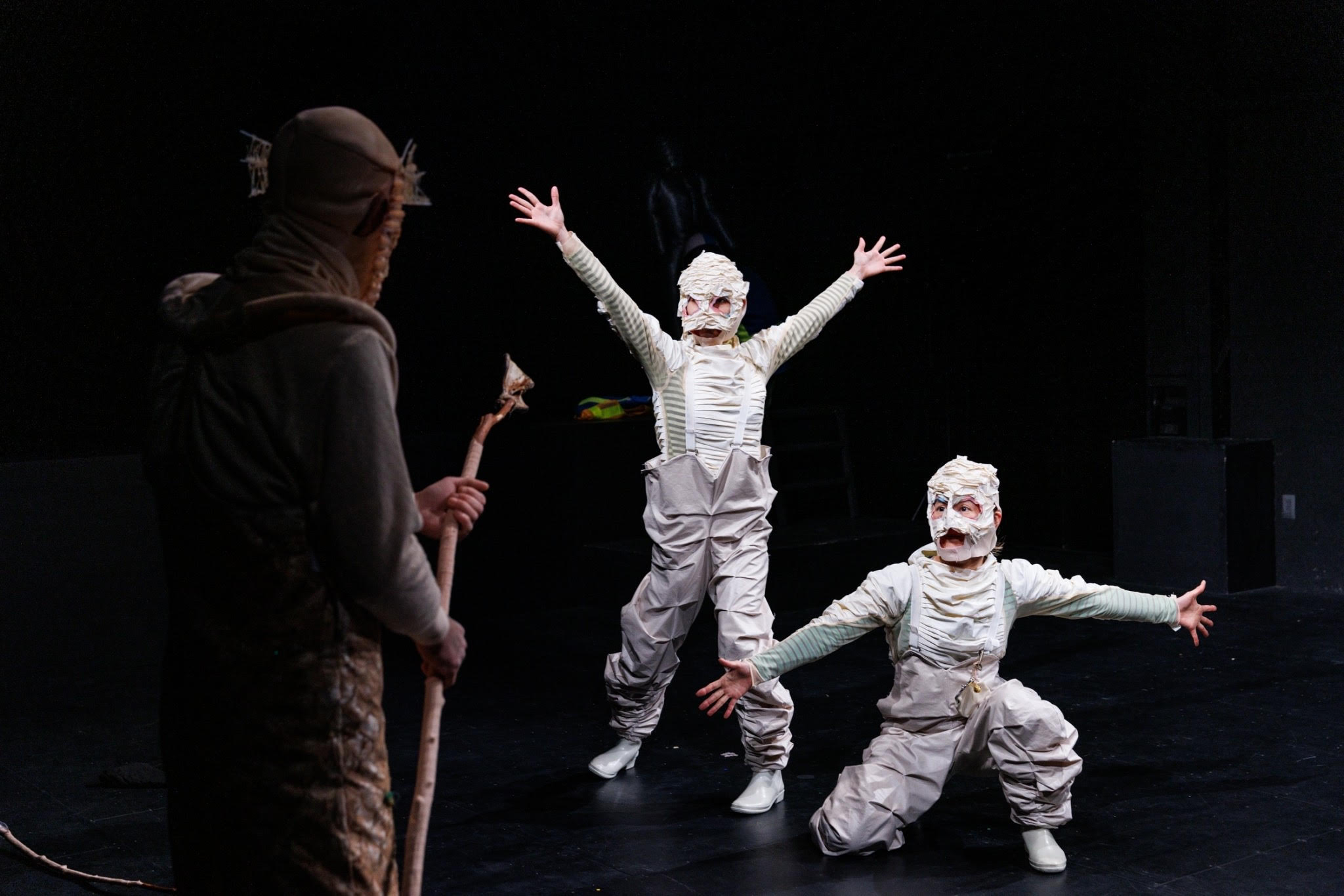Mariko Nishitani is a fashion editor and writer born in 1950.Nishitani was an editor at Bunka Publishing Bureau for So-en, High Fashion since 1974 until compulsory retirement in 2011,was the Paris bureau correspondent in 1980-1982.She was the chief editor for High Fashion Online until 2012.Exhibition she co-curated : »Feel and Think :A New Era of Tokyo Fashion « at Tokyo Opera City Art Gallery(2011). She is the author and editor for several books on fashion, including « Fashion Begins to Talk, 2011 »,» Relativism of COMME des GARÇONS, 2012 ». She has worked as the professor of Kyoto Seika University,faculty of popular culture,fashion course in 2013-2023.
“gesuidou” Photo by manami tanaka
Solving the riddles of what can and can’t be seen
My first time watching a play by Osushi was in December 2019 at the Rohm Theatre in Kyoto, where the company performed “Hello – Shinju (Hello – Love Suicides),” a contemporary play based on the ningyo joruri (puppet theater) classic “Love Suicides at Sonezaki.” The director, who (perhaps) wanted to see how a fashion writer without expertise in the field of theater would view the play, had asked me to review it, so I made the trip from Tokyo to Kyoto, watching the work twice. While the story was interesting, I was even more surprised and impressed by the concept of the play’s costumes. I noted the relationship between the puppeteer of ningyo joruri and the “puppets” played by humans, and the outlandish costumes worn by these “puppets” on stage. The “puppet” Tokubei, portrayed by a dancer, hardly uttered a word, but radiated indescribable power both in the moments of silence when he remained immobile and while he was moved by the puppeteer. I couldn’t help but take an interest in director, playwright, and costume designer Shie Minamino’s intentions behind using a dancer (Yuki Goda) for this role instead of an actor.
Dancers also appear in “Helen and gesuidou,” the subject of this review.
The two-part work begins with “Helen,” which is followed by “gesuidou.”
Parts one and two are related, but not continuous.
Depending on how you look at it, you could say that the first part is a dance production and the second a theater piece.
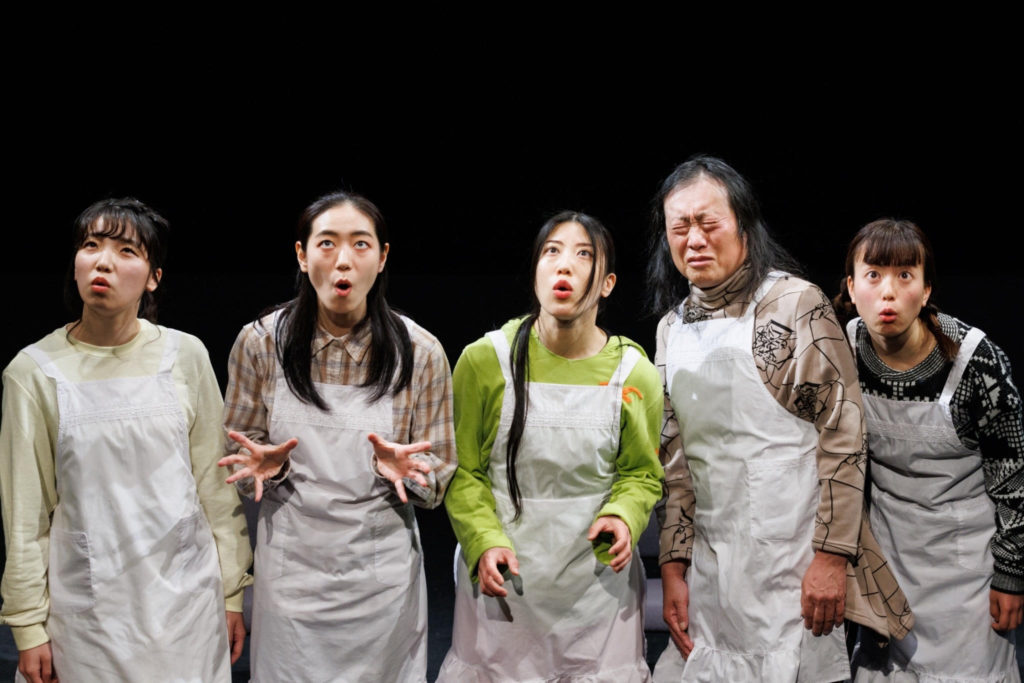
“Helen” Photo by manami tanaka
“Helen” starts as follows:
The curtain opens, and five women (six in the Kyoto performance) carrying small chairs appear one by one. They place the chairs at equal distance from each other and sit on them. The scene resembles an elementary school classroom. The schoolchildren, played by adults, are dressed in sweaters, pants, and socks of their liking. On top, they wear white aprons as if these were school uniforms. A greeting: “Good morning.” As they stand up, everyone is looking upward, and one by one, they reply to something above them, as if in code, only to be rebuffed (or so it seems). After this tense session, the atmosphere becomes more relaxed, as if recess had started. The students start playing games. When lunchtime comes, it appears, they say what they ate, one by one. Or maybe it’s what they want to eat.
This seems to be an everyday classroom scene, but I, as a spectator, cannot enter it. I don’t know the relationships between the characters. Nevertheless, the movements of each of the figures are intriguing and keep me interested. I begin to think that this might be a dance performance. Some of the movements remind me of menstruation and sanitary napkins, and I understand the matter to be something of interest to girls around the age of their first period.
No script or performance notes are available for sale, and the program for “Helen and Gesuidou” placed in the seats contained little in the way of plot or commentary. Having read Osushi’s Twitter feed, I knew that “Helen” refers to Helen Keller. But Helen Keller does not appear in the play.
Shie Minamino read Helen Keller’s biography when she was in elementary school, and before finalizing the script for this play, she penned another story inspired by Keller. “Five or six years ago I wrote a story about Helen and her peers who had a handicap (faced difficulties in life). It hasn’t been published. There was a lot of dialogue in it, and the character of (Anne) Sullivan was included. It’s a story of Helen and others like her who lack the skills considered necessary to live in this world, who are jealous, whine, persist, and raise their voices about their complexes and difficulties in life. It’s a completely different work from ‘Helen’ of ‘Helen and Gesuidou,’ but it certainly underlies it.”
Although I didn’t get a chance to read this story of Helen and her peers who face difficulties in life, I was able to sense the same kind of troubles in the girls appearing in “Helen,” whose uneven movements signaled difficulty in adjusting to life in a group.
Shie Minamino also compares the famous anecdote of Helen Keller learning the word “water” by touching actual water (a state of being) to her own experience. “(Helen Keller) learned that things and states have names, learned words, learned words that express this world, learned communication, learned to relay her thoughts to others, and found her connection to the world,” she says. “This synchronizes with my own experience of realizing that I’m able to connect with the world through words, stories, and various media.”
This personal interpretation of Helen Keller, or rather, a deep reading of Keller by drawing upon herself, may have brought to light various issues that Minamino encountered during her own growth as a person and that accumulated without her being able to untangle them (not a few of which seem to be problems unique to women)—issues now crystallized in the form of a play.
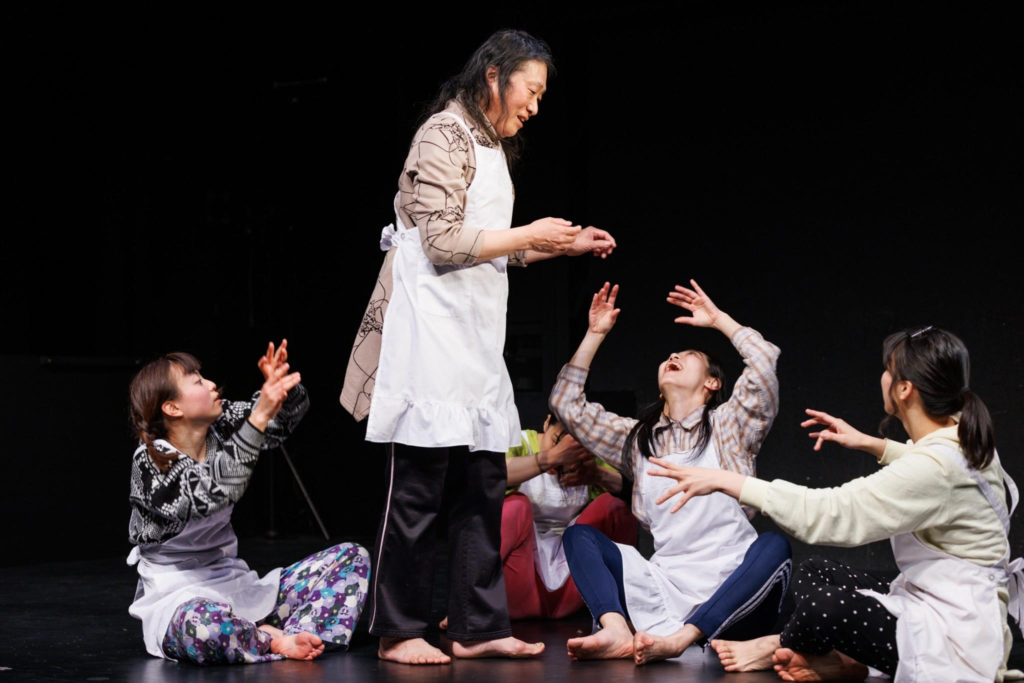
“Helen” Photo by manami tanaka
Having received the performance text, I understood that what the girls in the classroom were looking up at was a six-meter-tall Ms. Sullivan. As the text contained few passages about Part One, many of the words uttered on stage could have been improvised by the actors (including the dancers). Over time, those lines have spilled over from my memory, but the performers’ movements, tone of voice, and facial expressions remain very memorable.
Back when I worked as a fashion magazine editor (more than a decade ago), there were several times when, instead of using professional models, I purposely cast ordinary people in the streets for fashion pages. As a result, the photos on these pages had a special intensity to them, brought on by a sense of presence and opacity that couldn’t be produced by models. Watching “Helen,” I was reminded of those times. Uneven individuality can be memorable precisely because of its heterogeneity. Take Yumi’s “performance,” for example. When describing what she ate (or wanted to eat) for lunch, she differs from her peers by mentioning food unlikely to appear in a school lunch (such as game meat, more appropriate for a restaurant menu). At times, the tone of her voice suddenly becomes muffled, and when she dances, her movements are slow. But the look of sheer compassion on her face will remain in my memory. On the opposite end of the spectrum, Ayako Saito’s “acting” was superb, with every movement from her eyes to the fingertips meticulously executed. I did not mind at all the discrepancy between the two.
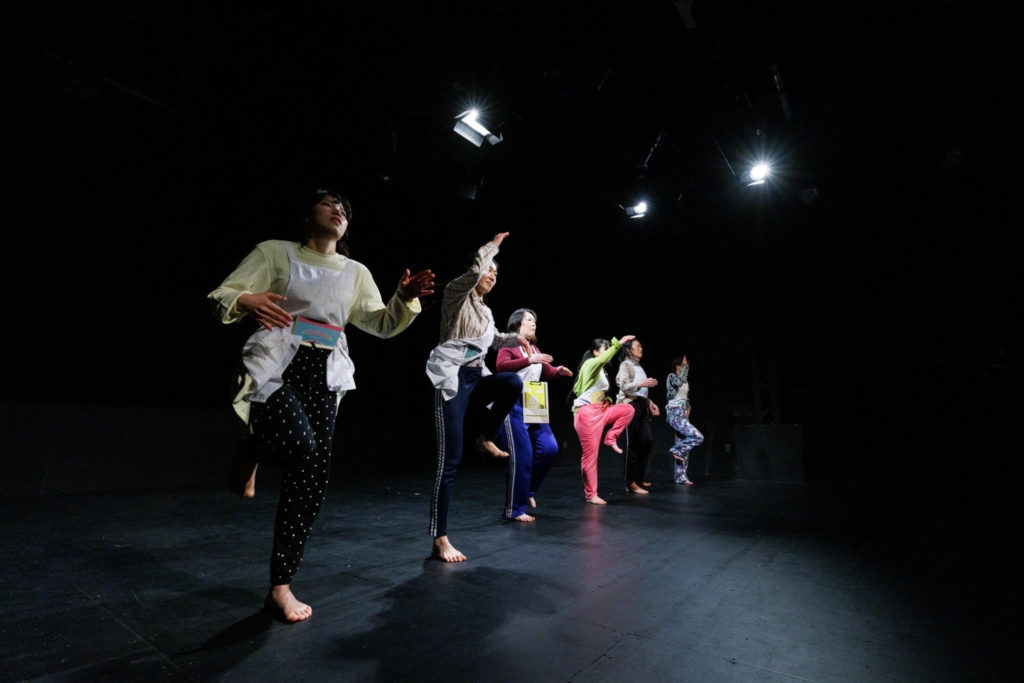
“Helen” Photo by manami tanaka
Let me touch on another point that emerged during a Q&A with Minamino. The question was, “What made you decide to take up Helen Keller in the first place?” Her answer was very serious.
“I feel that our world is blind to anything outside ‘the standard,’ because we have been ‘educated’ to be like that. ‘Standards’ are values that have been established, and we’ve also been taught not to show things that ‘aren’t supposed to be seen.’ But now, with developments in diversity, body positivity, and gender, some things are finally coming into view. I feel there’s still much that I myself am not capable of seeing.”
“It started with the question of what state of being is one in which we truly ‘see.’ That led me to question everything.”
As a result of this, it seems, Osushi has distanced itself from performing arts considered “good” in terms of dance or acting, pivoting its creative process instead to daily inspection and renewal through different “eyes.”
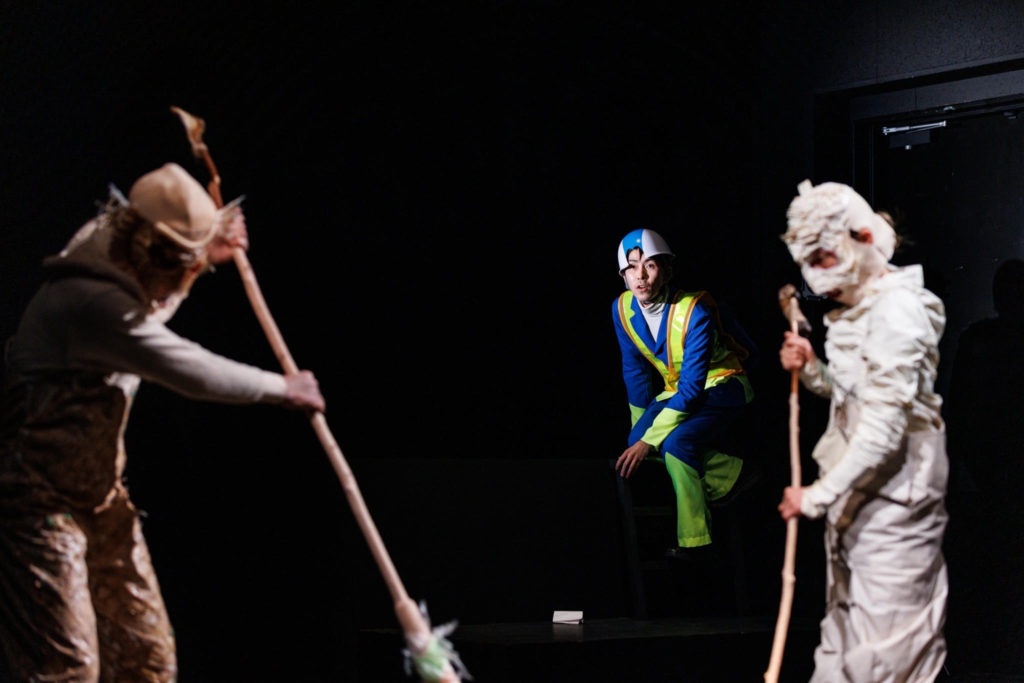
“Helen” Photo by manami tanaka
Let’s move to Part Two, “gesuidou.” Compared to Part One, it’s more “theatrical.”
Part Two takes place in a gesuidou, a sewage treatment plant. In a factory-like room, two workers in strange but elaborate and beautiful costumes and masks are using long sticks to stir up a spot on the ground where sewage seems to have accumulated. A man in a helmet and an ordinary business suit appears. He has come to observe. One of the workers gets upset and tries to turn him away in unconvincing language; from their conversation, we learn that the more experienced of the workers is named Hanako and that they have been doing this stirring for decades. The purpose of the work is to prevent the sewers from clogging, but according to the performance text, a mysterious life form has been born in the gesuidou. Hanako, not wanting the man in the helmet to find out about it, spends the first half of the play struggling to distract him. In the end, the mysterious life form never becomes a topic of discussion. Hanao, who works alongside Hanako, is new to the stirring business, but in the second half of the story we learn that he/she is actually a magician in training. Hanao then uses his/her magic to conjure up an alter ego that looks exactly like him/her, which gives rise to an absurd situation when Hanao fails to erase the alternate. The sewage system, a place normally unseen by people, where wastewater and excrement are discarded and go to die, comes to host a life form that can’t be flushed away.
If “Helen” lays out the difficulties women face in their respective lives, what is the meaning of “gesuidou”? It could be described as a tale about Hanako (in the story, despite the distinction from Hanao, the character’s sex remains unclear), who knows nothing about menstruation, reproduction, abortion, or childbirth because they have spent their life working in a place beyond the reach of other people’s gaze. But no correct answer is in sight. As Minamino says, we may be blind to what is “not standard.” She doesn’t show us an answer. Perhaps the theme of this work is to encourage reflection about what we cannot see.
“Helen and gesuidou” is both interesting and esoteric, and for that reason, it compels one to think. In closing, the costumes and headpieces sported by Hanako and Hanao (and the alter ego) are superb, contrasting with the mundane clothes worn by the other characters. As I also felt after watching “Hello – Shinju,” the exceptional contrast between the uneventful and the extraordinary is one of the aspects that makes Osushi so “delicious.”
Translated by Ilmari Saarinen
INFORMATION
Osushi: “Helen and gesuidou” Tokyo performances
Date: February 1–5, 2023
Venue: Komaba Agora Theater
Writing, directing, costumes: Shie Minamino
Joint research: Sho Takiguchi
Cast: “Helen” Katori 4, Ayako Saito, Tamaki Seki, Kanako Tsutsui, Yae Nokubo, Yumi
“Gesuidou” Kazusige Uchida, Eiji Oishi, Manami Fukuoka
Kyoto performances
Date: January 27–28, 2023
Venue: Theatre E9 Kyoto


